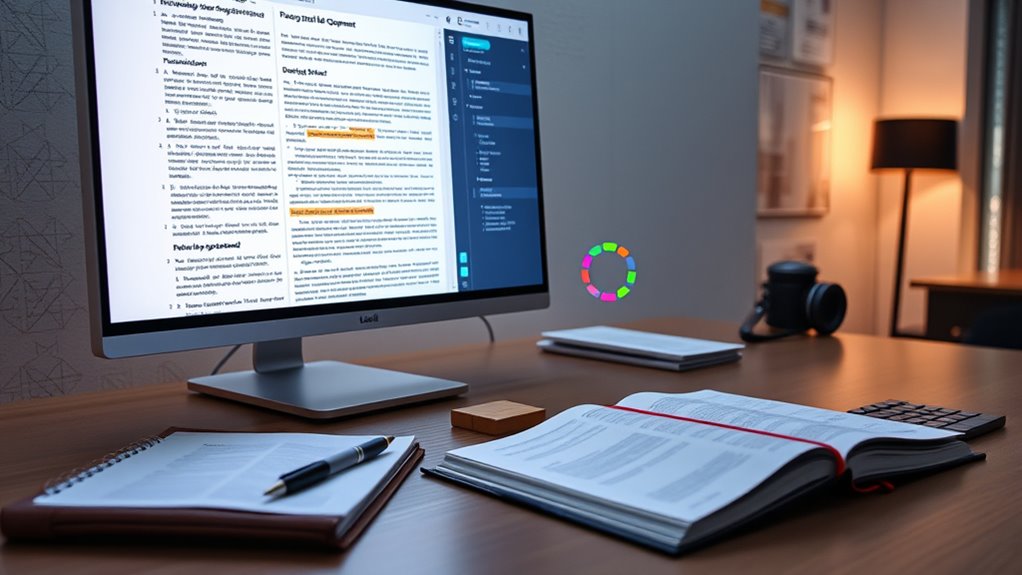AI-enabled legal document drafting tools help you automate contract creation, review, and revision, saving time and reducing manual effort. They guarantee consistency by standardizing language and flagging errors early, which minimizes risks. These tools also provide data-driven insights to improve document quality and support strategic decisions. As they learn from your feedback and data, they become more effective over time. Keep exploring to discover how these solutions can transform your legal workflows.
Key Takeaways
- Automates contract creation by populating templates with relevant data, reducing drafting time and manual effort.
- Ensures consistency and minimizes errors through standardization of language and style guidelines.
- Analyzes legal data to predict outcomes, identify potential issues, and tailor documents to specific jurisdictions or industries.
- Learns from user feedback to improve accuracy, adapt to practice nuances, and streamline workflow integration.
- Performs automated quality control, flagging risks and ensuring compliance before finalizing documents.

Have you ever wondered how artificial intelligence is transforming the way legal professionals draft documents? AI-enabled legal document drafting tools are revolutionizing the legal landscape by streamlining processes and enhancing accuracy. One of the key features driving this change is contract automation, which allows you to generate, review, and revise contracts more quickly than ever before. Instead of manually drafting lengthy documents from scratch, you can leverage AI to automatically populate templates with relevant data, identify potential issues, and suggest modifications. This not only saves time but also reduces the risk of errors that often slip through manual review.
AI simplifies legal drafting by automating contracts and reducing errors, saving time and increasing accuracy.
Alongside contract automation, legal analytics plays a vital role in improving your drafting process. By analyzing vast amounts of legal data, AI tools can identify patterns, predict outcomes, and provide insights that inform your document creation. For example, legal analytics can help you understand how similar contracts have performed in the past, highlighting clauses that are most likely to be enforceable or problematic. This data-driven approach enables you to craft documents tailored to specific jurisdictions, industries, or client needs, ultimately making your work more precise and effective.
Using AI-powered drafting tools, you can also guarantee consistency across multiple documents. These systems can standardize language, enforce style guidelines, and maintain uniformity in terminology, which is especially valuable when managing large volumes of contracts. Furthermore, AI can flag inconsistencies or ambiguous language that might otherwise go unnoticed, helping you mitigate potential disputes or compliance issues before they arise. The ability to quickly compare clauses across different documents using legal analytics further streamlines your review process, making it easier to identify risks or opportunities for improvement.
Another advantage is the continuous learning aspect of AI tools. As they process more documents and gather user feedback, they become smarter and more personalized to your practice. This means that over time, your drafting becomes faster and more accurate, with the AI adapting to your preferences and the specific nuances of your work. Plus, these tools often come with user-friendly interfaces, reducing the learning curve and allowing you to integrate them seamlessly into your workflow.
Moreover, the integration of AI-enabled document review features allows for even more efficient quality control, ensuring that your documents meet high standards before finalization. In essence, AI-enabled legal document drafting tools are transforming how you approach legal work. By automating routine tasks through contract automation and harnessing the power of legal analytics, you gain more efficiency, consistency, and insight. This technology empowers you to focus on higher-value activities, such as strategic advising and complex negotiations, while the AI handles the repetitive, time-consuming aspects of document creation.
Frequently Asked Questions
How Secure Are Ai-Driven Legal Document Platforms?
You’re likely wondering about the security of AI-driven legal document platforms. These platforms aim to protect your data privacy through encryption and access controls, but ethical considerations remain. Always verify the platform’s security protocols and data handling policies. While they endeavor to safeguard sensitive information, no system is completely foolproof. Stay informed about their security measures to ensure your legal data stays private and ethically managed.
Can AI Tools Replace Human Legal Expertise Entirely?
Thinking AI tools can replace human expertise is like expecting a robot to replace a seasoned chef; it’s not quite possible. While AI can handle routine tasks efficiently, it lacks the nuanced judgment only humans bring. AI ethics and human oversight are essential to guarantee accuracy and fairness. So, no, AI tools can’t fully replace human legal experts—they’re more like helpful assistants than complete substitutes.
What Are the Costs Associated With Adopting AI Drafting Tools?
When considering adopting AI-enabled legal drafting tools, you need to do a thorough cost analysis. The costs include initial setup, licensing fees, and ongoing maintenance. You’ll also face implementation challenges, such as training staff and integrating new systems with existing workflows. While these investments can streamline your processes, it’s essential to weigh the upfront and hidden costs to determine if the benefits outweigh the expenses.
How Do AI Tools Handle Jurisdiction-Specific Legal Language?
You wonder how AI tools tackle jurisdiction-specific legal language. They analyze jurisdictional nuances by learning from vast legal data, adapting language to fit local legal norms. These tools incorporate rule-based algorithms and machine learning models to customize legal language, ensuring compliance and clarity. By continuously updating their databases, they refine jurisdictional understanding, making legal documents more precise and tailored to each region, effectively bridging legal language adaptation gaps.
What Are the Potential Errors or Limitations of Ai-Generated Documents?
You might face accuracy issues or contextual misunderstandings with AI-generated documents, as the technology sometimes misinterprets subtle legal nuances or specific jurisdictional language. These tools rely on data and algorithms, which can overlook complex legal concepts or recent updates. As a result, your documents could contain errors or gaps, making it essential to review and verify AI drafts carefully to guarantee they meet legal standards and accurately reflect your intentions.
Conclusion
You won’t believe how AI-enabled legal document drafting tools are revolutionizing your work—turning hours into seconds, reducing errors to near zero, and making complex legal language a breeze. If you’re not already using these tools, you risk falling hopelessly behind in the legal world’s lightning-fast race. Embrace this technology now, or be forever stuck in the past, struggling with outdated methods while your competitors soar ahead with the power of AI at their fingertips.









